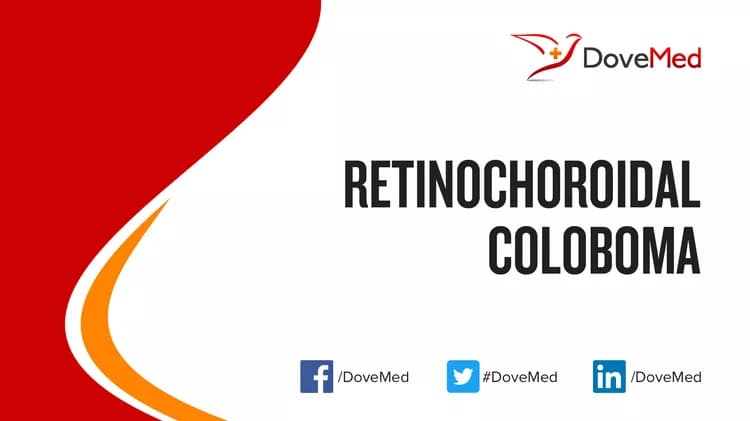What are the other Names for this Condition? (Also known as/Synonyms)
- Choroidal Coloboma
- Coloboma of Choroid and Retina
- Retinal Coloboma
What is Retinochoroidal Coloboma? (Definition/Background Information)
- Retinochoroidal Coloboma is an eye abnormality that occurs before birth. It is characterized by missing pieces of tissue in both the retina (the light-sensitive tissue lining the back of the eye) and choroid (the blood vessel layer under the retina)
- In many cases, Retinochoroidal Coloboma does not cause symptoms. However, complications such as retinal detachment may occur at any age
- Other possible complications include loss of visual clarity or distorted vision; cataract; and abnormal blood vessel growth in the choroid (choroidal neovascularization)
- Retinochoroidal Coloboma can involve one or both eyes, and may occur alone or in association with other birth defects
- It can be inherited or can occur sporadically
(Source: Retinochoroidal Coloboma; Genetic and Rare Diseases Information Center (GARD) of National Center for Advancing Translational Sciences (NCATS), USA.)
Who gets Retinochoroidal Coloboma? (Age and Sex Distribution)
- Retinochoroidal Coloboma is a rare congenital disorder. The symptoms of the disorder may be present at birth, in some cases
- Both males and females may be affected
- Worldwide, individuals of all racial and ethnic groups may be affected
What are the Risk Factors for Retinochoroidal Coloboma? (Predisposing Factors)
- A positive family history may be an important risk factor, since Retinochoroidal Coloboma can be inherited
It is important to note that having a risk factor does not mean that one will get the condition. A risk factor increases one’s chances of getting a condition compared to an individual without the risk factors. Some risk factors are more important than others.
Also, not having a risk factor does not mean that an individual will not get the condition. It is always important to discuss the effect of risk factors with your healthcare provider.
What are the Causes of Retinochoroidal Coloboma? (Etiology)
The exact cause of development of Retinochoroidal Coloboma is presently unknown. It is reportedly a genetic disorder that may be inherited, in some cases. However, researchers also believe that it may occur sporadically, without a previous family history.
What are the Signs and Symptoms of Retinochoroidal Coloboma?
- In many cases, Retinochoroidal Coloboma does not cause symptoms. However, complications such as retinal detachment may occur at any age
- Other possible complications include loss of visual clarity or distorted vision; cataract; and abnormal blood vessel growth in the choroid (choroidal neovascularization)
- Retinochoroidal Coloboma can involve one or both eyes, and may occur alone or in association with other birth defects
(Source: Retinochoroidal Coloboma; Genetic and Rare Diseases Information Center (GARD) of National Center for Advancing Translational Sciences (NCATS), USA.)
How is Retinochoroidal Coloboma Diagnosed?
Retinochoroidal Coloboma is diagnosed on the basis of the following information:
- Complete physical examination
- Thorough medical history evaluation
- Assessment of signs and symptoms
- Laboratory tests
- Imaging studies
- Biopsy studies, if necessary
Many clinical conditions may have similar signs and symptoms. Your healthcare provider may perform additional tests to rule out other clinical conditions to arrive at a definitive diagnosis.
What are the possible Complications of Retinochoroidal Coloboma?
Retinochoroidal Coloboma complications that commonly occur include:
- Tear or detachment of the retina (retinal detachment)
- Growth of new blood vessels beneath the retina that disrupt vision (choroidal neovascularization)
- Clouding of the lens (cataracts)
- Increased eye pressure leading to damage to the optic nerve (glaucoma)
(Source: Retinochoroidal Coloboma; Genetic and Rare Diseases Information Center (GARD) of National Center for Advancing Translational Sciences (NCATS), USA.)
Complications may occur with or without treatment, and in some cases, due to treatment also.
How is Retinochoroidal Coloboma Treated?
- There is no cure for Retinochoroidal Coloboma. Treatment varies depending on the conditions or complications that present in each individual. In some instances, Retinochoroidal Colobomas do not cause any symptoms and treatment is not necessary
- Treatment of retinal detachment depends on the severity of the condition
- For smaller retina tears, laser surgery (photocoagulation) or freezing treatment (cryopexy) may be utilized to induce a scar that helps to secure the retina to the eye wall
- For larger tears or a detachment, surgery is typically needed to place the retina back into its proper position
- Options may include: Scleral buckle, pneumatic retinopexy, or vitrectomy
- Surgical treatment of retinal detachment in individuals with Retinochoroidal Coloboma can be challenging and has variable success
- Treatment for choroidal neovascularization may include administration of medications that can block the abnormal growth of blood vessels (anti-VEGF treatment), thermal laser treatment to destroy abnormal blood vessels, and photodynamic therapy to damage unwanted blood vessels
- Cataracts are usually treated surgically via a technique called phacoemulsification. In this procedure, an instrument is used to break up and remove the cloudy lens. A lens implant is then placed to allow light to pass through and focus properly on the retina
- Glaucoma treatment varies and may include medication or surgery. Various surgical techniques can be utilized including: Laser trabeculoplasty, laser iridotomy, peripheral iridotomy, trabeculectomy, and aqueous shunt surgery. The goal of surgery in glaucoma is to reduce the pressure on the eye
(Source: Retinochoroidal Coloboma; Genetic and Rare Diseases Information Center (GARD) of National Center for Advancing Translational Sciences (NCATS), USA.)
How can Retinochoroidal Coloboma be Prevented?
Currently, Retinochoroidal Coloboma may not be preventable, since it is reported to be a genetic disorder.
- Genetic testing of the expecting parents (and related family members) and prenatal diagnosis (molecular testing of the fetus during pregnancy) may help in understanding the risks better during pregnancy
- If there is a family history of the condition, then genetic counseling will help assess risks, before planning for a child
- Active research is currently being performed to explore the possibilities for treatment and prevention of inherited and acquired genetic disorders
Regular medical screening at periodic intervals with tests and physical examinations are recommended.
What is the Prognosis of Retinochoroidal Coloboma? (Outcomes/Resolutions)
- The visual outlook (prognosis) for people with colobomas varies greatly and depends on the severity and extent of involvement. In many cases, Retinochoroidal Colobomas do not cause any symptoms
- However, complications are not uncommon and often cause decreased visual acuity or distorted vision, especially when they extend to the macula or optic disc. A complication can develop at any age throughout life
- The most common complications are retinal detachment (in up to 43% of cases) and choroidal neovascularization (abnormal growth of new blood vessels in the choroid)
- Visual acuity has been found to be worse in people who have associated structural abnormalities (particularly retrobulbar cyst) or retinal detachment
- Colobomas without microcornea (abnormally small cornea) or microphthalmia (abnormally small eyes) reportedly have the best visual prognosis, while complex colobomas associated with microphthalmia and retrobulbar cysts have the worst visual prognosis
- Early recognition and treatment of any associated complications, including cataracts, glaucoma, and retinal detachment, is important
(Source: Retinochoroidal Coloboma; Genetic and Rare Diseases Information Center (GARD) of National Center for Advancing Translational Sciences (NCATS), USA.)
Additional and Relevant Useful Information for Retinochoroidal Coloboma:
The following DoveMed website link is a useful resource for additional information:
Related Articles
Test Your Knowledge
Asked by users
Related Centers
Related Specialties
Related Physicians
Related Procedures
Related Resources
Join DoveHubs
and connect with fellow professionals


0 Comments
Please log in to post a comment.